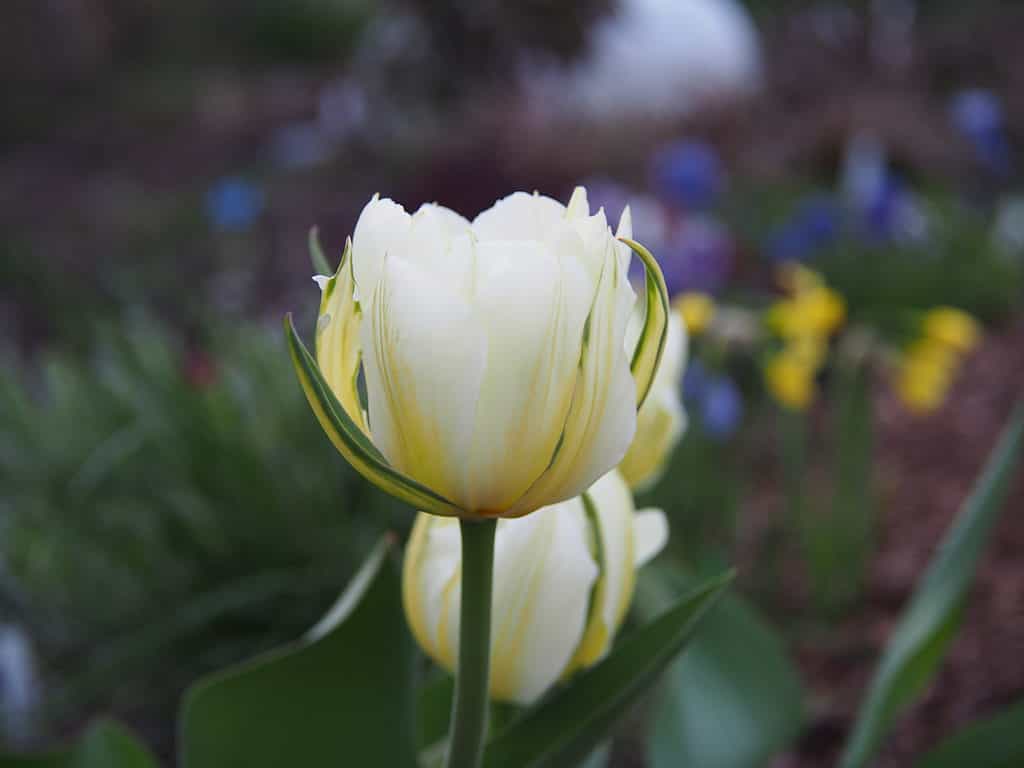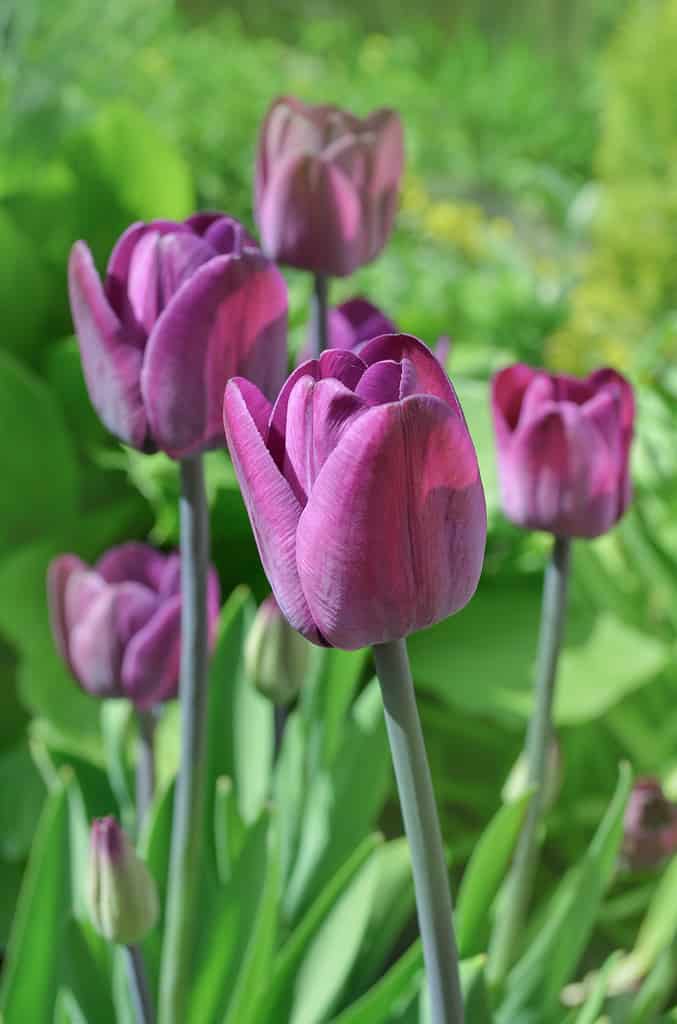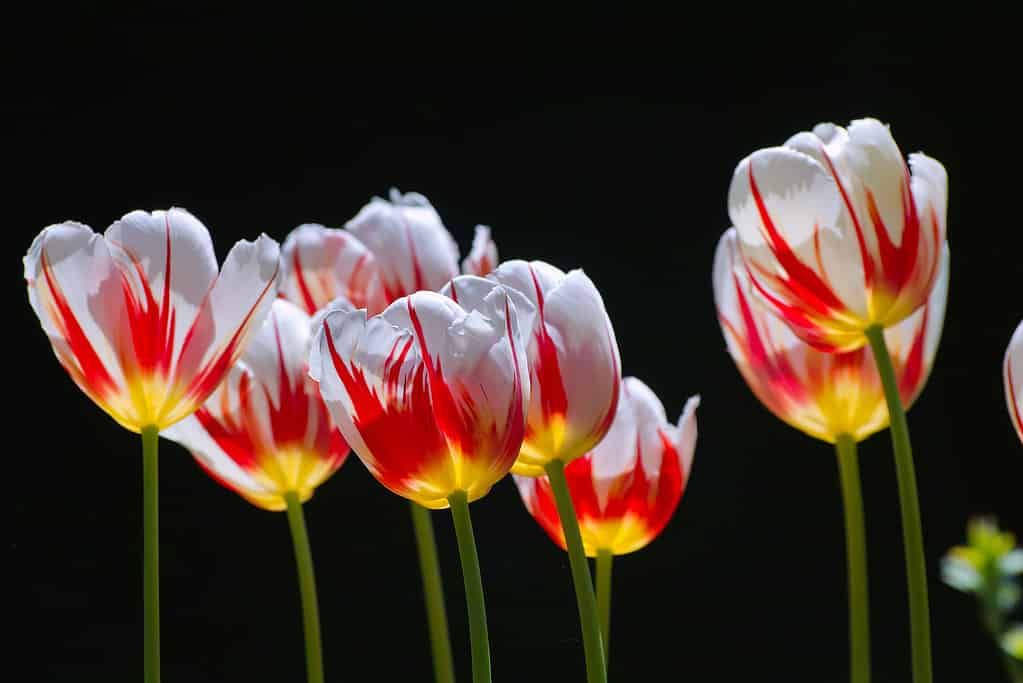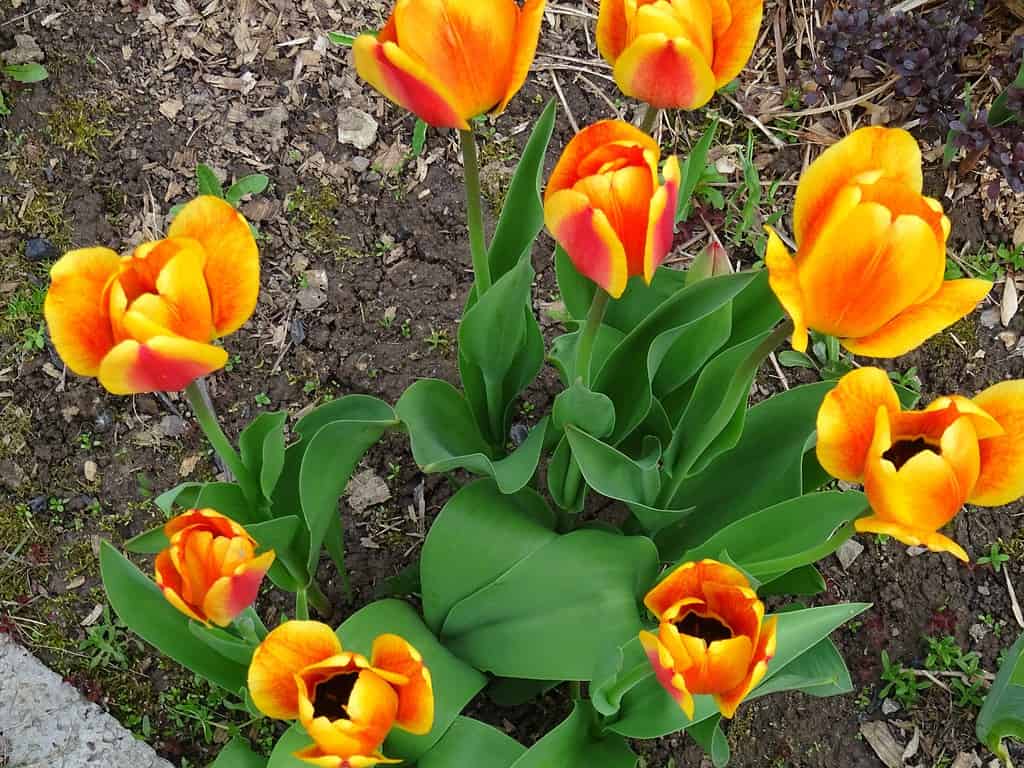Tulips originated in Central Asia and were first cultivated by the Turks in the Ottoman Empire during the 10th century. They were highly prized for their vibrant colors and unique shape. In fact, they were a symbol of wealth and status. Tulips gained widespread popularity in the 16th century when they were introduced to Western Europe. In the United States, the first record of tulips dates back to the early 17th century. Tulips rapidly gained popularity among American gardeners, and by the 19th century, numerous tulip varieties grew across the country. Massachusetts experiences cold winters, which provide the necessary period of dormancy tulip bulbs require to set their blooms. The state’s spring season offers the right combination of cool temperatures and moisture to foster tulip blooms. So, grab a floppy hat and a pair of gardening gloves as we discover seven eye-catching tulips to grow in Massachusetts.
Growing Tulips In Massachusetts
Growing tulips in the Bay State couldn’t be easier. Thanks to its humid continental climate, characterized by warm summers and cold winters with year-round precipitation, Massachusetts is home to an exceptionally favorable climate for cultivating tulips! The best time to plant tulip bulbs in Massachusetts is in the fall, 6-8 weeks before the ground freezes. This allows the bulbs to establish roots before winter.
Choose a site with well-drained soil and ample sunlight. Tulips thrive in full sun, though they can tolerate partial shade. Prepare the soil by loosening it and removing any weeds. Add organic matter, such as compost, to improve soil fertility and drainage. Dig a hole that is about three times the height of the bulb. This is usually 6-8 inches (12-20 cm) deep. Place the bulb in the hole with the pointed end facing up. Plant tulip bulbs 4-6 inches (10-12 cm) apart to allow for proper growth and air circulation.
After the tulips have finished blooming, deadhead them, while allowing the foliage to die back naturally. This helps supply energy to the bulb for the next year’s growth. Avoid cutting back the foliage until it turns yellow or brown.
1. Apeldoorn
Tulipa ‘Apeldoorn’ is a popular cultivar of tulip that is known for its striking beauty and vibrant color. It belongs to the Triumph tulip group, which is a hybrid group that combines the best characteristics of early and late-flowering tulips. Apeldoorn features large, cup-shaped flowers with a classic tulip shape. The petals can be red sometimes with a hint of purple, or mostly yellow with scarlet accents. The outer petals often have a slightly darker shade than the inner petals, creating a beautiful contrast.
The flowers of Apeldoorn are relatively large, measuring 3-4 inches (7.5-10 cm) in diameter when fully open. The stems can reach a height of 18-20 inches (45-50 cm), making them suitable for flower arrangements. Apeldoorn is an early to mid-spring bloomer, typically flowering in early May in Massachusetts. This tulip variety has a sturdy and upright growth habit, with strong stems that support the flowers well. The foliage is typically green and narrow, serving as an attractive backdrop to the vibrant blooms.

The petals of
Tulipa ‘Apeldoorn’can be red with a hint of purple, or mostly yellow with scarlet accents.
©jannoon028/Shutterstock.com
2. Blushing Lady
Tulipa ‘Blushing Lady’ is a charming and delicate tulip cultivar that displays soft and elegant colors. Its soft, blush-pink edges add a gentle touch to the garden, making it a popular choice for those seeking a subtle and graceful spring display. Blushing Lady features large, cup-shaped flowers with a graceful form. The petals are predominantly creamy yellow with subtle peach-pink edges that create a soft and romantic look. As the flowers mature, the pink hue intensifies, resulting in a lovely blush coloration.
The blooms of Blushing Lady are typically medium-sized, reaching 2.5-3 inches (6 -7.5 cm) in diameter when fully open. The stems can grow to a height of 16- 20 inches (40-50 cm), providing an elegant presence in the garden. Blushing Lady is a mid to late spring bloomer, usually flowering in May. Its flowering period coincides with the later stages of the tulip season, extending the display of blooms in the garden. This tulip variety exhibits a neat and upright growth habit. The stems are slender but sturdy, supporting the blooms well. The foliage is typically green and slender, creating a lush backdrop to the delicate flowers.

features large, cup-shaped flowers with a graceful form.
©Sergey V Kalyakin/Shutterstock.com
3. Carnival de Nice
Tulipa ‘Carnival de Nice’ is a vibrant head-turner known for its striking and multi-colored blooms.
It features large, showy flowers with a unique and captivating blend of colors. The petals exhibit a combination of bright red and white, creating a lively and carnival-like appearance. Each petal may have a different color pattern, with splashes, stripes, or flames of contrasting hues. The blooms of Carnival de Nice are typically medium to large, reaching 3-4 inches (7.5-10 cm) in diameter when fully open. The stems can grow to a height of between 16 and 20 inches (40-50 cm), providing a prominent presence in the garden. Carnival de Nice is a mid to late spring bloomer, usually flowering in May. Its vibrant and multi-colored blooms add a festive touch to the garden, creating a visual spectacle.

exhibits bright red and white petals, creating a lively and carnival-like appearance.
©Svetlana Mahovskaya/Shutterstock.com
4. Exotic Emperor
Tulipa ‘Exotic Emperor‘, is a striking tulip cultivar with cup-shaped flowers. The petals are generally creamy white to buttery, edged with green. The flowers of Exotic Emperor are smallish, measuring 2.5-3 inches (6-8 cm) in diameter when fully open. The stems can reach a height of between 14 and 20 inches (35-50 cm), adding to the visual impact of the plant. Exotic Emperor typically blooms in mid-spring and has a sturdy and upright growth habit. The stems are strong and reliable, ensuring the flowers remain upright even in adverse weather conditions.

Exotic Emperor typically blooms in mid-spring and has a sturdy and upright growth habit.
©Anna Gratys/Shutterstock.com
5. Greuze
Tulipa ‘Greuze’ is an heirloom tulip. The blooms are characterized by their rich purple color, creating a bold and eye-catching display in the garden. The petals are usually smooth and have a classic tulip shape. The flowers of Greuze are typically medium-sized, reaching 2-3 inches (5-7.5 cm) in diameter when fully open. The stems grow 16-20 inches (40-50 cm) tall. Greuze is a mid-spring bloomer, usually flowering in early May. Its intense purple blooms add a vibrant burst of color to the garden during the spring season. This tulip variety has a sturdy and upright growth habit. The stems are strong and provide excellent support to the flowers. The foliage is typically green and slender, providing an attractive backdrop to the striking purple blooms.

is a mid-spring bloomer, usually flowering in early May.
©LesiChkalll27/Shutterstock.com
6. Ice Follies
Tulipa ‘Ice Follies’ is a beautiful and popular tulip cultivar known for its elegant and distinctive blooms.
Ice Follies features large, cup-shaped flowers with creamy white petals streaked with red, and a soft, pale yellow or buttery yellow center. The outer petals often have a slightly feathered or ruffled edge, adding to their visual appeal. The contrast between the creamy white and pale yellow creates a classic and timeless look. The blooms of ‘Ice Follies’ are typically medium to large-sized, reaching 4-6 inches (10-15 cm) in diameter when fully open. The stems can grow to a height of 18-24 inches (45-60 cm), making them a prominent presence in the garden. Ice Follies is an early to mid-spring bloomer, typically flowering in early May. The Ice Follies tulip variety has a strong and upright growth habit. The stems are sturdy and support the flowers well. The foliage is typically green and narrow, providing a neat backdrop to the elegant blooms.

tulip variety has a strong and upright growth habit. The stems are sturdy.
©Ole Schoener/Shutterstock.com
7. Monsetta
Tulipa ‘Monsella’ is a delightful tulip cultivar known for its vibrant and cheerful blooms. Monsella features medium-sized flowers with a distinct and eye-catching coloration. The petals are predominantly a sunny yellow, with bold red accents. They have a classic tulip shape with a smooth and glossy texture. The blooms of Monsella measure 2.5-3 inches (6-7.5 cm) in diameter when fully open. The stems can grow to a height of 12-16 inches (30-40 cm). Monsella is an early to mid-spring bloomer, usually flowering in April. Its vibrant yellow blooms herald the arrival of spring and add a burst of color to the garden after the winter months.

The petals of
Monsellaare predominantly a sunny yellow, with bold red accents.
©Elena D Lisanina23101074992310107499/Shutterstock.com
The photo featured at the top of this post is © jannoon028/Shutterstock.com
Thank you for reading! Have some feedback for us? Contact the AZ Animals editorial team.







